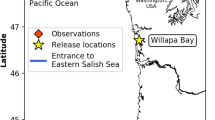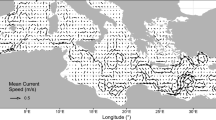Abstract
The rapid spread of Mnemiopsis leidyi across the entire Baltic Sea after its first observation in 2006 gave rise to the question of its invasion pathway and the possible vector of its transport. To investigate pathways of M. leidyi invasion, the years 2005–2008 have been simulated by a three-dimensional coupled sea ice-ocean model of the Baltic Sea. In addition, a Lagrangian particle-tracking model has been utilized to test possible transport routes of this invader for 2006/2007. Based on the model, we exclude advection from the Kattegat as the main area of origin of M. leidyi and further spreading through the entire Baltic Sea. To explain the dispersion of M. leidyi in 2007 an earlier invasion already in 2005 is most probable. Alternatively, an invasion originating from main harbors with high ship traffic could also be a potential pathway. Drift simulations with drifter release in the main harbors are in good agreement with the observed distribution pattern of M. leidyi.



Similar content being viewed by others
References
Carlton, J. T., 1999. The scale and ecological consequences of biological invasions in the world’s oceans. In Sandlund, O. T. S. P. & A. Viken (eds) Invasive Species and Biodiversity Management. Kluwer, Dordrecht: 195–212.
Catford, J. A., R. Jansson & C. Nilsson, 2009. Reducing redundancy in invasion ecology by integrating hypotheses into a single theoretical framework. Diversity & Distributions 15: 22–40.
Dulvy, N. K., S. I. Rogers, S. Jennings, V. Stelzenmuller, S. R. Dye & H. R. Skjoldal, 2008. Climate change and deepening of the North Sea fish assemblage: a biotic indicator of warming seas. Journal of Applied Ecology 45: 1029–1039.
Elton, C. S., 1958. The Ecology of Invasions by Animals and Plants. Methuen, London, UK.
Faasse, M. A. & K. M. Bayha, 2006. The ctenophore Mnemiopsis leidyi A. Agassiz 1865 in coastal waters of the Netherlands: an unrecognized invasion? Aquatic Invasions 1: 270–277.
Gollasch, S. & E. Leppaekoski, 2007. Risk assessment and management scenarios for ballast water mediated species introductions into the Baltic Sea. Aquatic Invasions 2: 313–340.
Gorokhova, E., M. Lehtiniemi, S. Viitasalo-Frösen & H. D. Haddock, 2009. Molecular evidence for the occurrence of ctenophore Mertensia ovum in the northern Baltic Sea and implications for the status of the Mnemiopsis leidyi invasion. Limnology and Oceanography 54: 2025–2033.
Haslob, H., C. Clemmesen, M. Schaber, H. H. Hinrichsen, J. O. Schmidt, R. Voss, G. Kraus & F. W. Köster, 2007. Invading Mnemiopsis leidyi as a potential threat to Baltic fish. Marine Ecology Progress Series 349: 303–306.
Hinrichsen, H. H., A. Lehmann, M. A. St. John & B. Brügge, 1997. Modelling the cod larvae drift in the Bornholm Basin in summer 1994. Continental Shelf Research 17(14): 1765–1784.
Hinrichsen, H. H., U. Böttcher, F. W. Köster, A. Lehmann & M. A. St. John, 2003a. Modelling the influences of atmospheric forcing conditions on Baltic cod early life stages: distribution and drift. Journal of Sea Research 49: 187–201.
Hinrichsen, H. H., A. Lehmann, C. Möllmann & J. O. Schmidt, 2003b. Dependency of larval fish survival on retention/dispersion in food limited environments: the Baltic Sea as a case study. Fisheries Oceanography 12(4/5): 425–433.
Hinrichsen, H. H., A. Lehmann, C. Petereit & J. Schmidt, 2007. Correlation analysis of Baltic Sea winter water mass formation and its impact on secondary and tertiary production. Oceanologia 49(3): 381–395.
Jackson, J. B. C., M. X. Kirby, W. H. Berger, K. A. Bjorndal, L. W. Botsford, B. J. Bourque, R. H. Bradbury, R. Cooke, J. Erlandson, J. A. Estes, T. P. Hughes, S. Kidwell, C. B. Lange, H. S. Lenihan, J. M. Pandolfi, C. H. Peterson, R. S. Steneck, M. J. Tegner & R. Warner, 2001. Historical overfishing and the recent collapse of coastal ecosystems. Science 293: 629–637.
Janas, U. & A. Zgrundo, 2007. First record of Mnemiopsis leidyi A. Agassiz 1865 in the Gulf of Gdańsk (southern Baltic Sea). Aquatic Invasions 2: 450–454.
Javidpour, J., U. Sommer & T. A. Shiganova, 2006. First record of Mnemiopsis leidyi A. Agassiz 1865 in the Baltic Sea. Aquatic Invasions 1: 299–302.
Javidpour, J., J. C. Molinero, J. Peschutter & U. Sommer, 2009. Seasonal changes and population dynamics of the ctenophore Mnemiopsis leidyi after its first year of invasion in the Kiel Fjord, Western Baltic Sea. Biological Invasions 11: 873–882.
Kinlan, B. P. & A. Hasting, 2005. Rates of population spread and geographic range expansion. In Sax, D. F., J. J. Stachowicz & S. D. Gaines (eds) Species Invasions, Insights into Ecology, Evolution, and Biogeography. Sinauer Associates, Sunderland, MA: 480 pp.
Kot, M., M. A. Lewis & P. vanden Driessche, 1996. Dispersal data and the spread of invading organisms. Ecology 77: 2027–2042.
Kube, S., L. Postel, C. Honnef & C. B. Augustin, 2007. Mnemiopsis leidyi in the Baltic Sea – distribution and overwintering between autumn 2006 and spring 2007. Aquatic Invasions 2: 137–145.
Lehmann, A., 1995. A three-dimensional baroclinic eddy-resolving model of the Baltic Sea. Tellus 47: 1013–1031.
Lehmann, A. & H. H. Hinrichsen, 2000. On the wind driven and thermohaline circulation of the Baltic Sea. Physics and Chemistry of the Earth, Part B: Hydrology, Oceans and Atmosphere 25: 183–189.
Lehmann, A., W. Krauss & H.-H. Hinrichsen, 2002. Effects of remote and local atmospheric forcing on circulation and upwelling in the Baltic Sea. Tellus 54A: 299–316.
Lehtiniemi, M., J. P. Pääkkönen, J. Flinkman, T. Katajisto, E. Gorokhova, M. Karjalainen, S. Viitasalo & H. Björk, 2007. Distribution and abundance of the American comb jelly (Mnemiopsis leidyi) – a rapid invasion to the northern Baltic Sea during 2007. Aquatic Invasions 2: 445–449.
Lockwood, J. L., M. F. Hoopes & M. P. Marchetti, 2007. Invasion Ecology. Blackwell publishing, Oxford, UK: 304 pp.
Mack, R. N., D. Simberloff, W. M. Lonsdale, H. Evans, M. Clout & F. A. Bazzaz, 2000. Biotic invasions: causes, epidemiology, global consequences, and control. Ecological Applications 10: 689–710.
MacKenzie, B. R. & D. Schiedek, 2007. Daily ocean monitoring since the 1860s shows record warming of northern European seas. Global Change Biology 13(7): 1335–1347.
Novotny, K., K. G. Liebsch, R. Dietrich & A. Lehmann, 2005. Combination of sea-level observations and an oceanographic model for geodetic applications in the Baltic Sea. In Sanso, F. (ed.), A Window on the Future of Geodesy, Vol. 128 of Springer Series of IAG Symposia. Springer, New York: 195–200.
Occhipinti-Ambrogi, A. & D. Savini, 2003. Biological invasions as a component of global change in stressed marine ecosystems. Marine Pollution Bulletin 46: 542–551.
Parmesan, C. & G. Yohe, 2003. A globally coherent fingerprint of climate change impacts across natural systems. Nature 421: 37–42.
Purcell, J. E., T. A. Shiganova, M. B. Decker & E. D. Houde, 2001. The ctenophore Mnemiopsis leidyi in native and exotic habitats: U. S. estuaries versus the Black Sea basin. Hydrobiologia 451: 145–176.
Reusser, D. A. & H. Lee, 2008. Predictions for an invaded world: a strategy to predict the distribution of native and non-indigenous species at multiple scales. ICES Journal of Marine Science 65: 742–745.
Roohi, A., Z. Yasin, A. E. Kideys, A. T. S. Hwai, A. G. Khanari & E. Eker-Develi, 2008. Impact of a new invasive ctenophore (Mnemiopsis leidyi) on the zooplankton community of the Southern Caspian Sea. Marine Ecology 29: 421–434.
Schneider, G., 1987. Role of advection in the distribution and abundance of Pleurobrachia pileus in Kiel Bight. Marine Ecology Progress Series 41: 99–102.
Shiganova, T. A. & Y. V. Bulgakova, 2000. Effects of gelatinous plankton on Black Sea and Sea of Azov fish and their food resources. ICES Journal of Marine Science 57: 641–648.
Tendal, O. S., K. R. Jensen & H. U. Riisgård, 2007. Invasive ctenophore Mnemiopsis leidyi widely distributed in Danish waters. Aquatic Invasions 2: 46–455.
Acknowledgments
Authors are grateful to J. C. Molinero for his valuable comments on the article. This work was financed by IFM-GEOMAR.
Author information
Authors and Affiliations
Corresponding authors
Additional information
Handling editor: D. J. Lonsdale
Rights and permissions
About this article
Cite this article
Lehmann, A., Javidpour, J. Potential pathways of invasion and dispersal of Mnemiopsis leidyi A. Agassiz 1865 in the Baltic Sea. Hydrobiologia 649, 107–114 (2010). https://doi.org/10.1007/s10750-010-0233-8
Received:
Revised:
Accepted:
Published:
Issue Date:
DOI: https://doi.org/10.1007/s10750-010-0233-8




